past issues

|
Published monthly for CC employees by Clinical
Center Communications
May 2000
Pediatric clinic opens
Employee survey reveals perceptions
Radiology pioneer Dr. John Doppman retires
Hepatitis C virus changes to evade immune system
Plans move ahead for new Clinical Research Information System
Help Desk launched
Nursing's Estrin retires after 32 years
Summers's award
Sunshine inside
News briefs
|
|
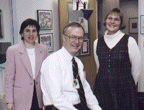 |
Dr.
John Hurley, center, heads the new pediatric outpatient clinic.
Dr. Deborah Merke, left, heads the pediatric inpatient units.
Barbara Corey, R.N., M.S.N., right, is the nurse manager for
pediatrics. |
Pediatric clinic opens
Outpatient clinic rounds out pediatric services
A new pediatric outpatient clinic opened last month on the
9th floor of the ACRF. Headed by Dr. John Hurley, a board-certified
pediatrician and pediatric nephrologist, the clinic is for children
who come to the CC as outpatients but may need other health services
while here. Hours are Mondays and Thursdays from 1 to 4 p.m.
The clinic's nurse is Kelly Cahill, R.N.
A 1998 NIH policy mandated that children be included in all
human-subjects research unless scientific or ethical reasons
exist for not including them.
As a result, investigators are caring for more small patients
than ever before. But kids have special needs or can develop
non-protocol-related problems that a pediatrician can help with.
"The clinic is a place where investigators can refer
a child with a condition they might not be familiar with,"
said Dr. Hurley, who joined the CC in December after a 20-year
career with Kaiser Permanente.
Non-protocol-related pediatric illnesses, nutrition, growth
and development, school problems, immunizations, and common-drug
administration are areas where the clinic can provide guidance
and advice.
"I hope that investigators won't think very long about
whether to refer a patient to the clinic," said Dr. Hurley.
"We are here to support and help whenever possible."
Dr. Johnson Liu, of NHLBI's Hematology Branch, tried the new
clinic when a child in his anemia protocol developed a fever.
"We weren't sure if the fever was related to the anemia
or to some other condition. It was very useful to be able to
refer to Dr. Hurley's clinic." Another of Dr. Liu's young
anemia patients has diabetes as well, which Dr. Hurley can help
keep an eye on.
The new clinic is not to be confused with the 13-West and
9-West inpatient pediatric units, headed by Dr. Deborah Merke.
That's where all the CC's pediatric inpatients are cared for.
Rooms have sleeping accommodations for one parent, and there
is a playroom for recreation and relaxation.
Dr. Merke is a board-certified pediatrician and pediatric
endocrinologist. She spent 5 years with NICHD before joining
the CC in January of 1999. The nurse manager for pediatrics is
Barbara Corey, R.N., M.S.N.
A pediatric day hospital, also located on 9-West, offers a
transitional level of care. Services include chemotherapy, administration
of blood, and serial testing and specimen collections.
A pediatric consult service rounds out the CC's comprehensive
program of child-centered care. Investigators may request a one-time
consultation for an acute pediatric problem or multiple consultations
for help in the management of chronic conditions.
To schedule outpatient appointments, enter a request in MIS
[pediatric consultation]. If urgent, also page Dr. Hurley or
the on-call pediatrician. If routine, also call the appointment
clerk at 6-6821 (push "0" to access clerk).
--by Sue Kendall
Back to top
|
|
Employee survey reveals perceptions
What did we say?
The following is a tiny
sample of the comments written by CC employees in the recent
survey:
"Honest straightforward
communication, even when it's a message I might not want to hear."
"Eliminate the extensive
committees."
"Increase communication
between management and employees."
"More autonomy within
offices and departments."
"More flexible hours."
"Please fix the ITAS
payroll system."
"Less paperwork for
everything."
"Do not float nurses
so often."
|
|
Clinical Center management recently mailed surveys to 1800
CC staff to learn some overall impressions and opinions to discuss
at the annual department-heads retreat, held in March.
"The Clinical Center provides a high quality environment
for patient care," said CC Director Dr. John Gallin, "but
there is always room for improvement. We wanted to hear what
Clinical Center employees thought could be changed to make our
work environment even more pleasant and productive. We also wanted
to know what not to change."
The survey asked three questions, to which 244 people replied:
- What is the one thing you think is great about working at
the Clinical Center?
- What is a simple fix that you would recommend that could
really make the CC a better place to work?
- What is a more complex organizational change that you would
recommend to make the CC a better place to work?
"Opinions were plentiful due to the open-ended nature
of the questions," said Deputy Chief Operating Officer Elaine
Ayres. Each specific response was placed into a broad category,
such as communication or management.
What do we like about the CC?
- We like our co-workers. Comments cited competent, professional
staff, commitment and dedication to patient care and research,
collaborative and collegial atmosphere, and diversity of people,
jobs, and expertise.
- We like our mission. NIH's reputation, our involvement in
cutting-edge research, and the uniqueness of meshing clinical
care with research were all cited.
- We like the educational opportunities, including lectures,
classes, conferences, grand rounds, and in-services.
And the problems? Responses for the "simple or complex
fix" questions were so similar that they were pooled.
- Communication was the number one problem area, with 18 percent
of the responses. Some people want more communication between
departments; some want more information from and interaction
with the Office of the Director; some want better computer and
network facilities.
- "Information systems was seen as so important that those
comments related to it were extracted as a sub-category,"
said Ayres.
- Personnel issues came in second at 16 percent. Recruiting
and hiring staff in a timely manner, formal training for supervisors
and managers, and career-development opportunities were all cited
as areas that need attention.
- Third were management issues, at 15 percent. Paperwork, top-heavy
administration, and inconsistent policies were cited as barriers.
"As a result of discussions at the department-heads retreat,
working groups have been formed to address personnel, communication,
information systems, and planning issues," said Ayres. "The
latter group will address an issue that emerged as important
to department heads: how to better plan for sufficient equipment,
staff, space, and budgets to accommodate Institute priorities.
The groups will report back regularly at department-heads meetings,"
she said.
"Because employees work in such diverse settings, their
opinions and ideas are invaluable to the continual improvement
of CC services," Ayres stated. "Future surveys of CC
staff will provide not only additional ideas for growth, but
a way to measure our successes. We hope all employees will complete
future surveys."
--by Sue Kendall
Back to top
|
Radiology pioneer Dr. John Doppman retires
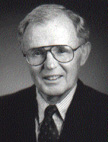
John L. Doppman, M.D.
|
Dr. John L. Doppman retired last month after 36 years of service
to the Clinical Center's Diagnostic Radiology Department, including
26 as its head.
Colleagues describe Dr. Doppman as a world-class angiographer,
a dedicated teacher, a generous friend, and all-around good guy.
He is a self-described workaholic, who has authored or co-authored
516 scientific papers and 38 book chapters or books.
An interventional radiologist, Dr. Doppman developed, refined,
and performed numerous semi-surgical radiologic procedures during
his lengthy career.
According to longtime colleague Dr. Richard Chang, "His
papers are constantly being cited, and the techniques he has
developed are used throughout the world. I used one of his procedures
earlier this week."
Recalling the early days of his specialty, Dr. Doppman said,
"We started out doing angiograms," a technique that
uses injections of radio-opaque dye to visualize blood vessels
and tumors. "Then we discovered we could dilate vessels
with balloons, drain abscesses, biopsy lungs, and put in central
lines. We now do a lot of things that surgeons used to do, all
under CT or x-ray control."
Later targeting his efforts at endocrinology the study
of glands and hormones Dr. Doppman developed techniques
for locating ectopic or elusive glandular tumors, which greatly
improved patients' chances for successful surgery.
He also became interested in vascular malformations of the
spinal cord. He developed a fundamental understanding of these
challenging lesions and devised ways to visualize and treat them.
His research culminated in the publication of the first text
on this subject in 1969.
Dr. Doppman has been a part of other innovations in radiology
that have revolutionized clinical care procedures we take
for granted today and that save us from invasive exploratory
surgery.
"While I've been here, ultrasound, CT scanning, interventional
radiology, and magnetic resonance imaging have all developed,"
he said. "In addition to running the department, a lot of
my responsibility was making sure we were state of the art in
diagnostic radiological equipment. We had one of the first CT
scanners and the 3rd or 4th MRI scanner in the country. It's
been a great pleasure to guide radiology through this period
of immense innovation."
Dr. Doppman earned his medical degree cum laude at Yale in
1953. He completed an internship at Mercy Hospital, in his hometown
of Springfield, Mass., and planned a career in general practice.
But after serving 3 years in the Navy, Dr. Doppman decided that
general medicine wasn't for him, and began searching for a specialty.
"Radiology was ideal, because it presented diagnostic
challenges and the chance to participate in therapies without
being the primary care physician." He returned to the East
for a radiology residency at the Hospital of St. Raphael, in
New Haven, Conn. He was also a Fullbright Fellow in Radiologic
Research at the Hammersmith Hospital, London, in 1959.
He joined the Clinical Center in 1964 as deputy chief of the
Diagnostic Radiology Department. Except for a 2-year stint as
a radiology professor at the University of California, San Diego,
he has been with the Radiology Department ever since.
Dr. Doppman received many honors for his work, including the
Gold Medal from the Society of Cardiovascular and Interventional
Radiology (1997), an organization of which he was also a founding
member and past president (1983); a Gold Medal from the American
Roentgen Ray Society (1998); the Copeland Award from M.D. Anderson
Cancer Center (1992); and the PHS Distinguished Service Medal
(1982), the highest award granted by PHS. His love of mentoring
was recognized in his being the 1997 recipient of the NIH Distinguished
Clinical Teacher Award. He also received the CC Director's Award
(1997) and the NIH Director's Award (1999).
Dr. Doppman has presented many named lectures and is an honorary
member of the radiological societies of England, Ireland, Germany,
and Hungary, as well as of the American Society of Endocrine
Surgeons.
Reflecting on his years at the Clinical Center, Dr. Doppman
said, "It's been a great place to work. All the CC directors
have been very generous to radiology. It's an expensive specialty,
but it's absolutely critical because the serious clinical problems
end up in radiology. We can provide definitive answers, and sometimes
we can even have a hand in correcting the problem itself."
Clinical Center Director Dr. John Gallin sums up the feelings
of many: "For many years John Doppman has been one of the
pillars of the NIH clinical research community. In addition to
being a very strong clinical scientist, he has been one of the
most important clinicians the Clinical Center has had. His enthusiasm
and skill helping with difficult clinical situations are unmatched.
Any time of the day or night, he would lend assistance to solve
difficult diagnostic or therapeutic problems. You always felt
you had the very best when Dr. Doppman was working with one of
your patients. We are all disappointed that his retirement has
become a reality, and we wish him the very best."
--by Sue Kendall
Back to top
|
Hepatitis C virus changes to evade immune system,
study finds
CC's stored blood samples crucial to findings
|
Researchers from the Clinical Center, NIAID, and other institutions
have discovered a clue to the mystery of why up to 85 percent
of patients fail to recover fully from an infection with the
hepatitis C virus (HCV). HCV is a major cause of chronic liver
disease, cirrhosis, and liver cell cancer.
Their research, reported in the April 14 issue of "Science,"
points to changes in surface proteins that enable the virus to
escape the immune system. The study shows that the destiny of
an HCV infection is determined during the initial, acute phase
of disease.
"We know that the hepatitis C virus can simultaneously
exist as a family of closely related but immunologically distinct
variants that has been termed 'quasispecies,'" said senior
author Dr. Harvey Alter, chief of the Infectious Diseases Section
of the CC's Department of Transfusion Medicine. "We have
patients who have 2030 different hepatitis C viruses in
their serum at one time. The question was whether this ability
of the virus to exist in these different forms could be a mechanism
to escape the host's immune response."
In a search for the answer, Dr. Alter offered a unique resource:
a storehouse of blood samples amassed from his long-term studies
of patients who contracted hepatitis from blood transfusions.
The samples provided a continual record of what the virus was
doing in each patient's bloodstream over, in some cases, 20 years.
"This unique group was critical for our study, because
they had been observed continuously since early in infection,"
stated lead author Dr. Patrizia Farci.
Samples were selected from the first 4 months of infection
in 12 patients with different clinical outcomes: acute HCV infection,
fulminant hepatitis (a rare but serious form of acute disease),
or chronic hepatitis. The research team examined serum samples
taken at different time points in each patient, looking specifically
for changes in the genes that encode special proteins coating
the viral surface. They also studied what changes occurred either
before or after the body's immune system responded to HCV infection.
"In some patients the immune response was sufficient
to neutralize the virus and decrease the variants, presumably
one by one, until the infection was eradicated and clinical recovery
ensued. But in other patients the immune response was insufficient
to clear the virus, and instead served to drive a system wherein
the virus kept escaping the immune attack by becoming more and
more diverse. These patients developed chronic liver disease,"
said Dr. Alter.
Similar mechanisms are used by other viruses, such as HIV
and influenza, but this is the first study to correlate such
behavior with disease progression in hepatitis C. The researchers
also determined a region in the virus surface protein (envelope)
where most of the changes occur.
Studies will now focus on the types of mutations that assist
HCV in avoiding the immune system, and on the types of antibodies
produced during the early response. "Once we understand
the host-virus interrelationships, we might be able to do things
to alter that relationship. Particularly, we might be able to
combine a strategy that would suppress viral replication with
one that would stimulate the immune response," Dr. Alter
said.
Dr. Alter's valued blood samples have been used in numerous
studies, and they are running low. "We've already run out
of some of these samples. They are irreplaceable, unfortunately.
We are a victim of our own success because we now have such good
screening measures that we no longer see any cases of transfusion-associated
hepatitis C. We are setting up a new prospective study to look
at other viruses, in addition to primary hepatitis viruses, and
to establish a comprehensive donor-recipient repository so that
if a new virus is discovered, we could immediately plug into
the samples and prove whether it is transfusion-transmitted and
hence a threat to the blood supply," Dr. Alter said.
Other collaborators from NIH, University of Cagliari, Kanazawa
University (Japan), Chiron Corporation, and Albert Einstein Medical
Center participated in this study.
Back to top
|
Plans move ahead for new Clinical Research Information System
Help Desk launched
The Clinical Center's Information
Systems Department (ISD) launched its "Help Desk" last
month. According to Chief Information Officer Richard Gordon,
"This new service allows CC computer users to call a single
telephone number, 4-9999, and place their computer problem into
a coordinated system of troubleshooting."
In the past, employees were
assigned to a specific ISD staff member for technical support.
Now, problems will be routed to whomever has expertise in that
area.
By use of software called
"Timbuktu," an ISD staffer will soon be able to interact
remotely with the problem computer. Once the problem is solved,
the requester will receive an e-mail notification. Requests can
also be e-mailed to: CCHelpDesk@mail.cc.nih.gov,
or logged in at the following web site: http://www.cc.nih.gov/HelpDesk.
The system also tracks the
nature of problems so that the most troublesome areas can be
identified. Users will be periodically surveyed to assess their
satisfaction. The Help Desk is staffed weekdays from 7 a.m. to
5 p.m. After hours, callers will be offered the option of leaving
a voice message or speaking with a computer operator, who will
take the information. The caller will later be contacted about
the problem.
"I encourage everyone
to try out the new system," said Gordon. "We know it
will take awhile to work out the kinks, but we ask for your patience
during the startup process."
|
|
You may have heard the acronym "CRIS" tossed about
lately. So, what is it?
CRIS stands for "Clinical Research Information System,"
and it isn't a stand-alone entity. Rather, according to Chief
Information Officer Richard Gordon, "it is a suite of computer
systems that will support many of the functional elements of
the Clinical Center." CRIS will eventually replace the aged
Medical Information System, or MIS.
"While MIS has served the CC for 25 years, it does not
support functions we need in today's world, such as digital imaging.
In areas where MIS could not meet a need, add-ons were devised,
resulting in a patchwork of systems, interfaces, and networks
that do not perform optimally together. The result is duplicated
effort and limited access to clinical research data," Gordon
said.
Components of CRIS will include new systems for pharmacy,
order entry, protocol management, medical-surgical care, charting,
appointment scheduling, and imaging, among many others.
"The goal is to have all these systems be able to 'talk'
to one another to provide investigators with access to real-time
clinical research data," Gordon said. "With CRIS, using
a Windows-style interface, we'll be able to take advantage of
things like menu trees, color, and sound to see at a glance all
the things that are associated with a patient, rather than having
to flip through lots of screens of data, like we currently do
with MIS."
Oversight for CRIS is provided by a steering committee, chaired
by NHLBI director Dr. Claude Lenfant. A project-management team,
headed by the CC's Dr. Steve Rosenfeld, will deal with day-to-day
decisions and details of the 5-year, $40 million project.
The "requirements analysis" phase is underway. That
means that a team is visiting all hospital areas to map out their
processes and discuss how information technology can help them
increase efficiency and effectiveness, both in the existing hospital
and in the new Clinical Research Center. The team's report is
called for by summer's end.
Then, an acquisition strategy will be mapped out. Gordon said
that plans call for use of commercial, off-the-shelf applications
wherever possible.
MIS will continue to be used until CRIS is fully operational.
Watch "Clinical Center News" for updates.
Back to top
|
Nursing's Estrin retires after
32 years
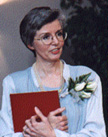
Maureen Estrin
|
Colleagues honored Maureen Estrin, nurse consultant for recruitment
and retention for the past 18 years, with a retirement reception
in March.
Estrin joined the Clinical Center nursing staff in 1967 as
a new BSN graduate of Villanova University.
During the summer of her junior year, she was a Junior COSTEP
(Commissioned Officer Student Training and Extern Program). As
part of that PHS program, she paid a 1-day visit to the Clinical
Center. That experience led to 32 years and 9 months of uninterrupted
service.
She spent 3 years as a staff nurse followed by 10 years as
head nurse on the medical oncology/dermatology floor. She served
as assistant chief of the cancer nursing service for 9 months
before moving into her current role in nursing recruitment and
retention.
Estrin grew up in Buffalo, N.Y., but now calls Olney home,
where she lives with her husband, Tom, a professional photographer.
She has two sons, Ian (21), who is in college, and Marc (15).
Retirement is simply a shift in direction for Estrin. "I'm
just ending one career and beginning the next. I plan to work
part-time at the Olney Theatre-not on the stage!- but with the
administrative staff. I really want to work close to home, staying
in our community."
As reported in "Nursing E-News," http://www.cc.nih.gov/nursing/.
Back to top
|
Summers's award
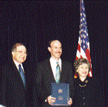
|
Dr. Ronald Summers, center, a staff radiologist with the CC's
Department of Diagnostic Radiology, received "The Presidential
Early Career Award for Scientists and Engineers" at a ceremony
held at the White House last month. The award, in its 4th year,
is the highest honor bestowed by the United States government
on young scientists and engineers. Dr. Summers was cited for
"developing special radiologic visualization techniques
such as virtual reality presentations that permit doctors and
patients to better understand disease and better plan treatment,"
the certificate stated. Dr. Summers was one of 60 government
professionals to receive the honor. Recipients receive up to
a 5-year research grant to further their study in support of
critical government missions. Also pictured are Dr. Ruth Kirschstein,
acting director of NIH, and Dr. Neal Lane, director of the White
House Office of Science and Technology Policy.
Back to top
|
Sunshine inside
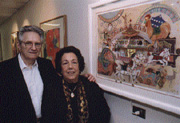
|
"Carousels of Sunshine," a motorized, lighted, musical
work of art, was donated to the Clinical Center by artist Arthur
A. Plant and his wife Theresa, of Columbia, Md. The carousel
hangs in the phlebotomy waiting area, near the Admissions Desk,
where it delights children and adults alike as they wait for
their blood draws. This is the 12th carousel Plant has created
and donated to hospitals over the past 7 years "because
of my belief in the healing powers of music, art, and beauty,"
he said. Over 50 people attended a reception last month in the
Medical Board Room, where Plant received a certificate of appreciation
for his donation.
Back to top
|
News briefs
Heart disease study
The Heart Disease Risk Factors in African-Americans Study
seeks new participants for a study of the relationship between
obesity and heart disease risk factors in healthy, nondiabetic
African-American men and women. Participants can be of normal
weight, overweight, or obese and between the ages of 18 and 55.
There will be a series of four outpatient visits to the Clinical
Center, in which participants will have body fat analyses, an
electrocardiogram, blood tests, including cholesterol profiles,
and oral and intravenous glucose tolerance tests. All participants
will be compensated. For more information, call 2-7119.
AIDS conference
The Fourth International AIDS Malignancy Conference will be
held May 1618 at the Natcher Conference Center. The program
includes lectures and presentations of abstracts. Registration
fee waived for NIH employees. For more information, go to http://ctep.info.nih.gov/,
and click on "AIDS Oncology Resources." Or call Jaime
Quinn at 6-0826.
Mammography
Mobile mammography screening starts this month. All NIH employees,
their families, and others associated with NIH may participate.
The van will be at various locations on campus. Consult the web
site at http://odp.od.nih.gov/whpp/events/mammography.html
for the latest on schedules and locations.
JCAHO web site
As preparations gear up for the fall visit by the Joint Commission
on the Accreditation of Healthcare Organizations, consult the
Clinical Center's JCAHO web site for informational updates and
overviews, and read the results of last month's mock survey.
Other topics include safety, the strategic plan, a new portal
for online (web) information resources, and competencies.
Parking renewals
NIH general parking permits for campus employees whose last
names begin with H, I, or J will expire on the last day of May.
To renew yours, visit the NIH Parking Office in Bldg. 31, Room
B3B04, weekdays between 7:30 a.m. and 4:30 p.m. Be sure to bring
your valid NIH identification card, driver's license, and valid
vehicle registration certificate for each vehicle to be registered.
Sleep study
NIMH researchers seek male and female volunteers, ages 2035, who
routinely sleep 9 hours or more per night or 6 hours or less per night.
Volunteers must have no sleep disturbances or insomnia, no history of
mental illness, and be in good general health and not taking any medications
or birth control pills. The study requires a 4-day stay on the research
unit. Compensation is available. Employees of NIMH are ineligible for
participation. For details call 6-5831.
Nursing Conference
The CC Nursing Department sponsors its 10th annual psychiatric nursing
conference, "Neuroscience and Genetic Research Updates," June
5-6. The program will be held in Wilson Hall. Details are online, http://www.cc.nih.gov/ccc/nurseconf/psyconf.html
Back to top
|
Clinical Center News, 6100 Executive
Blvd., Suite 3C01, MSC 7511, National Institutes of Health, Bethesda,
MD 20892-7511. Tel: 301-496-2563. Fax: 301-402-2984. Published
monthly for CC employees by the Office of Clinical Center Communications,
Colleen Henrichsen, chief. News, article ideas, calendar events,
letters, and photographs are welcome. Deadline for submissions
is the second Monday of each month.
Back to top | cc
home page | nih home
page |
|
|

